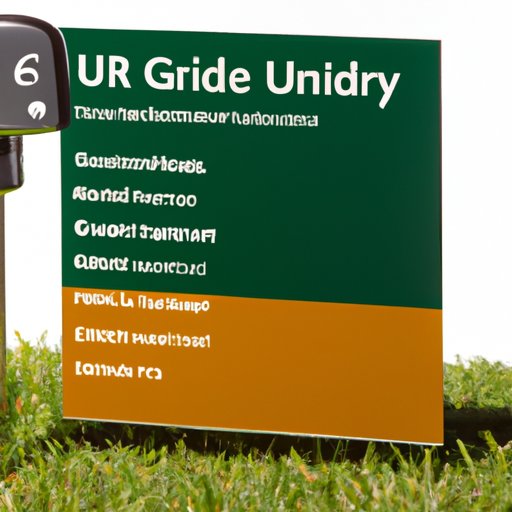Introduction
Golf is a game with a wide range of skill levels among players, which can make it difficult to fairly compare scores between players of different abilities. This is where handicapping comes in. A handicap is a numerical measure of a golfer’s potential ability, and it is used to even out the playing field by giving less skilled players a “head start” when competing against more advanced players. In this article, we’ll explore what handicapping is, how it works, and its various benefits for players of all levels.
Explaining the Rules and Regulations of Handicapping in Golf
At its core, handicapping is the process of assigning a numerical value to a golfer’s potential ability. This number is called a Handicap Index, and it is based on a player’s average scores over a period of time. The Handicap Index is calculated using a mathematical formula that takes into account the difficulty of different courses and factors in any adjustments that may be made to the score.
The Handicap Index is then adjusted according to the course being played, so that the same Index can be used across different courses and still provide an accurate representation of a player’s skill level. This adjustment is known as the Course Handicap, and it is used to determine the number of strokes a golfer is allowed to reduce their score when playing a particular course.
Examining the Benefits of Establishing a Handicap in Golf
Handicapping provides a number of benefits for golfers of all skill levels, as it helps create a more level playing field for players of different abilities. With a Handicap Index, players can compete against each other on an equal footing, regardless of their individual skill levels. This allows for a fairer comparison of scores and makes the game more enjoyable for everyone involved.
In addition, having a Handicap Index can help players track their progress and improve their performance. By tracking their scores and calculating their Handicap Index, players can identify areas for improvement and set goals for themselves. This can lead to better scores, which can result in increased enjoyment of the game.
Finally, having a Handicap Index can open up a variety of opportunities for players. Having an established handicap makes it easier to participate in tournaments and leagues, as it gives organizers an easy way to sort players by skill level. It also makes it easier to find playing partners who are of similar ability.

Investigating the Different Handicap Systems Used Around the World
There are several different handicapping systems used around the world, with the most prominent being the USGA System and the European System. The USGA System is the most widely used system in the United States, while the European System is used in many countries in Europe. There are also several regional handicapping systems used in other parts of the world.
All of these systems use the same basic principles, but they differ in the details. For example, the USGA System uses a sliding scale for calculating Handicap Indexes, while the European System uses a fixed scale. The USGA System also requires players to submit a minimum number of scores before they can receive a Handicap Index, while the European System does not.
Assessing How Handicaps Affect Scoring in Golf Tournaments
When playing in tournaments, handicaps can have a significant impact on scoring. In most tournaments, each player is given a Handicap Allowance, which is the number of strokes that the player is allowed to reduce their score. This allowance is based on the player’s Handicap Index and the difficulty of the course being played. Handicap Allowances are typically used in stroke play tournaments, where the lowest score wins.
In some tournaments, a different system called Handicap Stroke Control is used. This system limits the number of strokes that a player is allowed to reduce their score, regardless of their Handicap Index. This system is usually used in match play tournaments, where players compete against each other in one-on-one matches.

Analyzing the Impact of Handicaps on Professional Golfers
For professional golfers, handicapping is slightly different than it is for amateur players. Professional golfers have their own Handicap Indexes, but they are not used in tournaments or competitions. Rather, professional golfers use their Handicap Indexes to adjust their scores when playing practice rounds or recreational rounds.
In addition, professional golfers are also assigned a Professional Tour Handicap, which is used to determine their eligibility for certain tournaments. This Handicap is based on the player’s performance in previous tournaments and is updated regularly.

Debating the Pros and Cons of Handicapping in Golf
Handicapping in golf has both advantages and disadvantages. On the plus side, handicapping creates a more level playing field, making the game more enjoyable for players of all skill levels. It also allows players to track their progress and set goals for themselves, leading to improved performance. Finally, having a Handicap Index can open up a variety of opportunities for players, such as participating in tournaments and finding playing partners.
On the downside, handicapping can be seen as unfair to more skilled players, as they are forced to give strokes to less skilled players. This can lead to frustration and discourage players from playing their best. In addition, some players may feel that their Handicap Index is inaccurate, leading to confusion and dissatisfaction.
Conclusion
Handicapping is an important part of golf, as it helps create a level playing field for players of all skill levels. It also offers a number of benefits, such as allowing players to track their progress and opening up new opportunities. However, there are also drawbacks to handicapping, such as its perceived unfairness and the potential for inaccurate Handicap Indexes. Ultimately, whether or not to use handicapping is a personal decision, and it is up to each individual golfer to decide if it is right for them.


